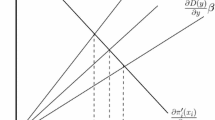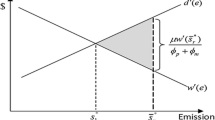Abstract
We examine an environmental policy which may be revisited by a new administration. We allow for pollution to be persistent over time and for uncertainty in next period's environmental policy. When pollution is non-persistent, we show that regulatory uncertainty is inconsequential for output, pollution, or emission fees. However, when pollution is persistent, we find that a more likely reelection of a stringent administration has the unintended (positive) consequence of reducing current pollution. We also measure the inefficiencies stemming from ignoring pollution persistence and from policy uncertainty, identifying in which contexts they are severe or negligible.


Similar content being viewed by others
Notes
Baker et al. (2013) propose a policy uncertainty index as a weighted average of: (1) a count of newspaper articles containing key terms related to policy uncertainty (this is the element receiving the highest weight on the index);
(2) the dollar impact of tax provisions set to expire in the near future (as a measure of uncertainty about future changes in the tax code); and (3) dispersion in economic forecasts of the CPI and government spending (as a proxy for uncertainty about fiscal and monetary policy).
Svensson et al. (2009) analyze an optimization model considering different types of uncertainty, such as future energy prices or policy instruments, and examine investments decisions in energy efficiency. However, they do not consider evaluate the inefficiencies from ignoring pollution persistence or policy uncertainty.
Our setting considers linear demand and production costs, and convex environmental damages, which are standard assumptions in the literature analyzing environmental regulation in oligopolistic industries, such as Poyago-Theotoky (2007), Ouchida and Goto (2014), Lambertini et al. (2017), and Haruna and Goel (2018); among others.
In particular, \({{\pi }_{i}(t}_{k}^{*})\) is decreasing in \(\alpha \) and \(X\) if and only if \({d}_{k}>\frac{1-c}{2\left(1-c\right)+4\alpha X}\), which holds since \({d}_{k}>1/2\) by definition.
References
Agnolucci, P. (2006). Use of economic instruments in the German renewable electricity policy. Energy Policy, 34(18), 3538–3548.
Aizenman, J., & Marion, N. P. (1993). Policy uncertainty, persistence and growth. Review of International Economics, 1(2), 145–163.
Armstrong, M., & Sappington, D. (2007). Recent developments in the theory of regulation. In Armstrong, M., & Porter, R. (Eds.) Handbook of industrial organization (Chapter 27; 3, pp. 1557–1700).
Baker, S.R., Bloom, N., & Davis, S. J. (2013). Measuring economic policy uncertainty. Chicago Booth Research Paper No. 13–02.
Barradale, M. J. (2010). Impact of public policy uncertainty on renewable energy investment: Wind power and the production tax credit. Energy Policy, 38(12), 7698–7709.
Bloomberg Magazine. (2018). Trudeau's Tough Climate Policies Face a Mounting Backlash by Christopher Flavelle and Josh Wingrove, July 20th, https://www.bloomberg.com/news/articles/2018-07-20/canadian-backlash-to-climate-policies-erupts-as-carbon-tax-looms.
Bontempi, M. E. (2015). Investment-uncertainty relationship: Differences between intangible and physical capital. Economics of Innovation and New Technology, 25(3), 240–268.
Dixit, A. K., & Pindyck, R. S. (1994). Investment under Uncertainty. Princeton University Press.
Elrod, A. A., & Malik, A. S. (2017). The effect of environmental regulation on plant level product mix: A study of EPA’s Cluster rule. Journal of Environmental Economics and Management, 83, 164–184.
Fabrizio, K. R. (2013). The effect of regulatory uncertainty on investment: Evidence from renewable energy generation. The Journal of Law, Economics, and Organization, 29(4), 765–798.
Gal-Or, E., & Spiro, M. H. (1992). Regulatory regimes in the electric power industry: Implications for capacity. Journal of Regulatory Economics, 4(3), 263–278.
Gilbert, R. J., & Newbery, D. M. (1994). The Dynamic Efficiency of Regulatory Constitutions. RAND Journal of Economics, 25(4), 538–554.
Gulen, H., & Ion, M. (2015). Policy Uncertainty and Corporate Investment. The Review of Financial Studies, 29(3), 523–564.
Hammar, H., & Lofgren, A. (2001). The determinants of sulfur emissions from oil consumption in Swedish manufacturing industry 1976–1995. The Energy Journal, 22(2), 107–126.
Haruna, S., & Goel, R. K. (2018). Optimal pollution control in a mixed oligopoly with research spillovers. Australian Economic Papers, 58, 21–40.
Joskow, P. L. (1989). Regulatory Failure, Regulatory Reform, and Structural Change in the Electrical Power Industry. Brookings Papers: Microeconomics (pp. 125–99).
Kolbe, L. A., & Tye, W. B. (1991). The duquesne opinion: How much “hope” is there for investors in regulated firms? Yale Journal on Regulation, 8, 113–157.
Lambertini, L., Poyago-Theotoky, J. A., & Tampieri, A. (2017). Cournot competition and “green” innovation: An inverted-U relationship. Energy Economics, 68, 116–123.
Lemoine, D. (2017). Green expectations: Current effects of anticipated carbon pricing. Review of Economics and Statistics, 99(3), 499–513.
Leonard, D., Kalt, J. P., & Lee, H. (1987). Re-establishing the Regulatory Bargain in the Electric Utility Industry. Harvard University, Energy and Environmental Policy Center, Discussion Paper no. E-87-02.
Lim, C., & Yurukoglu, A. (2018). Dynamic natural monopoly regulation: Time inconsistency, moral hazard, and political environments. Journal of Political Economy, 126(1), 263–312.
Lyon, T. P. (1991). Regulation with 20–20 Hindsight: “Heads I Win, Tails You Lose?” RAND Journal of Economics, 22, 581–595.
Lyon, T. P., & Mayo, J. W. (2005). Regulatory opportunism and investment behavior: Evidence from the U.S. electric utility industry. RAND Journal of Economics, 36(3), 628–644.
Lyon, T. P., & Li, J. (2004). Regulation Reputation and Regulatory Scope. Working paper, University of Michigan.
Meyer, N. I., & Koefoed, A. L. (2003). Danish energy reform: Policy implications for renewables. Energy Policy, 31, 597–607.
Ouchida, Y., & Goto, D. (2014). Do emission subsidies reduce emission? In the context of environmental R&D organization. Economic Modelling, 36, 511–516.
Poyago-Theotoky, J. A. (2007). The organization of R&D and environmental policy. Journal of Economic Behavior & Organization, 62, 63–75.
Rodrik, D. (1991). Policy uncertainty and private investment in developing countries. Journal of Development Economics, 36(2), 229–242.
Sappington, D. (1986). Commitment to regulatory bureaucracy. Information Economics and Policy, 2(4), 243–258.
Singh, N., & Vives, X. (1984). Price and quantity competition in a differentiated Duopoly. The RAND Journal of Economics, 15(4), 546–554.
Spiegel, Y., & Spulber, D. (1994). The Capital Structure of a Regulated Firm. RAND Journal of Economics, 25(3), 424–440.
Stein, L. C. D., & Stone, E. (2014). The Effect of Uncertainty on Investment, Hiring, and R&D: Causal Evidence from Equity Options. Working paper, Arizona State University.
Svensson, E., Berntsoon, T., Stromberg, A.-B., & Patriksson, M. (2009). An optimization methodology for identifying robust process integration investments under uncertainty. Energy Policy, 37(2), 680–685.
The Guardian (2018). Scott Morrison says national energy guarantee 'is dead'. September 7th, available at https://www.theguardian.com/australia-news/2018/sep/08/scott-morrison-says-national-energy-guarantee-is-dead.
Wiser, R., Boinger, M., & Barbose, G. (2007). Using the Federal Production Tax Credit to Build a Durable Market for Wind Power in the United States. The Electricity Journal, 20(9), 77–88.
Author information
Authors and Affiliations
Contributions
All authors equally contributed to the development of the model, calculations, writing of results, and reviewing of the paper.
Corresponding author
Ethics declarations
Competing interests
The authors declare no competing interests.
Additional information
Publisher's Note
Springer Nature remains neutral with regard to jurisdictional claims in published maps and institutional affiliations.
We would like to thank the editor, Menahem Spiegel, and reviewers for their helpful suggestions, and Georges Zaccour and Li-Hsien Hank Chien for their insightful comments. We are also grateful to seminar participants at the 15th Western Economic Association International conference in Tokyo, HEC Montreal, and Washington State University.
Supplementary Information
Below is the link to the electronic supplementary material.
Rights and permissions
Springer Nature or its licensor (e.g. a society or other partner) holds exclusive rights to this article under a publishing agreement with the author(s) or other rightsholder(s); author self-archiving of the accepted manuscript version of this article is solely governed by the terms of such publishing agreement and applicable law.
About this article
Cite this article
Espinola-Arredondo, A., Munoz-Garcia, F. & Garrido, D. Measuring regulatory errors from environmental policy uncertainty. J Regul Econ 64, 48–65 (2023). https://doi.org/10.1007/s11149-023-09464-z
Accepted:
Published:
Issue Date:
DOI: https://doi.org/10.1007/s11149-023-09464-z




